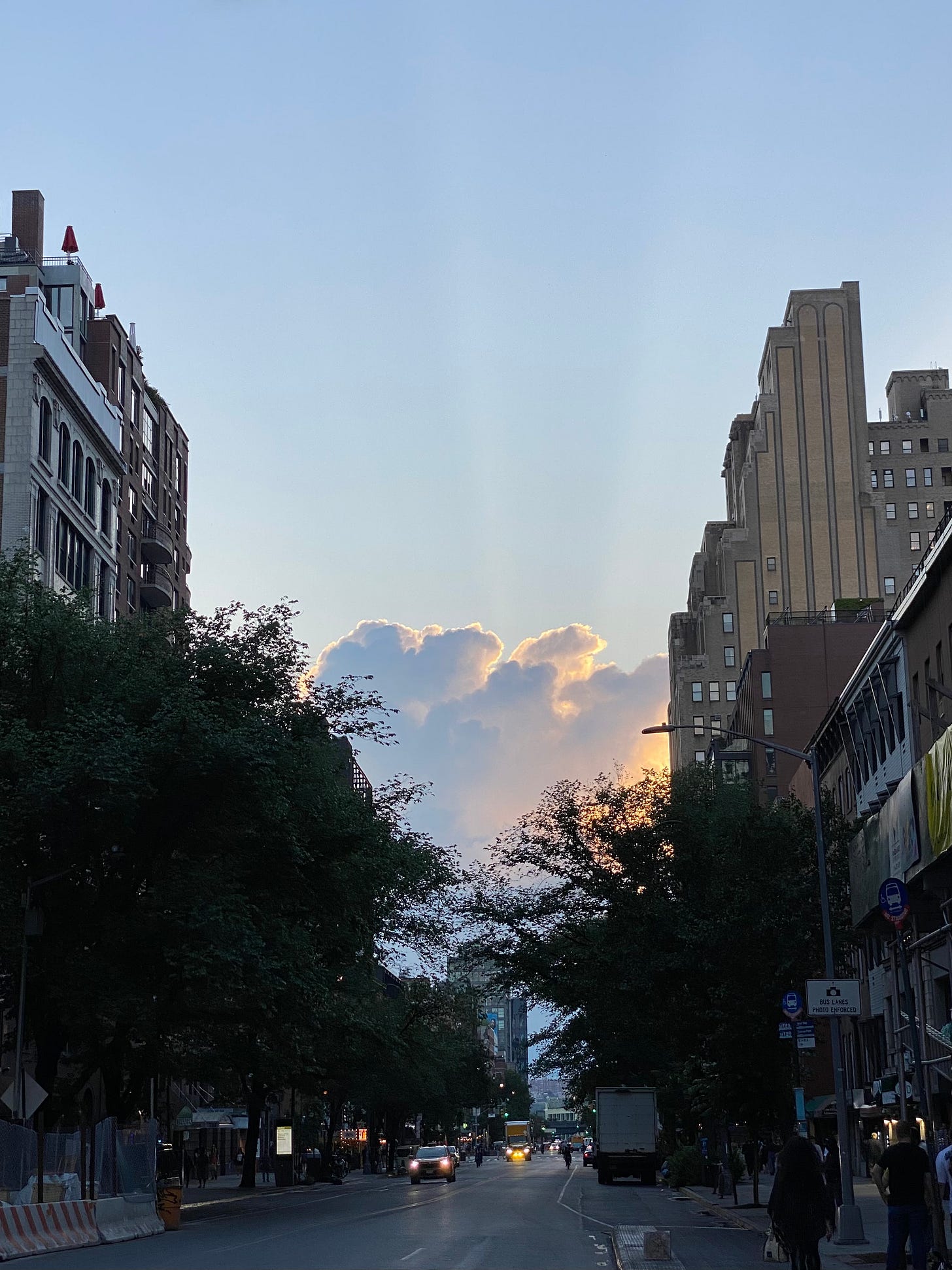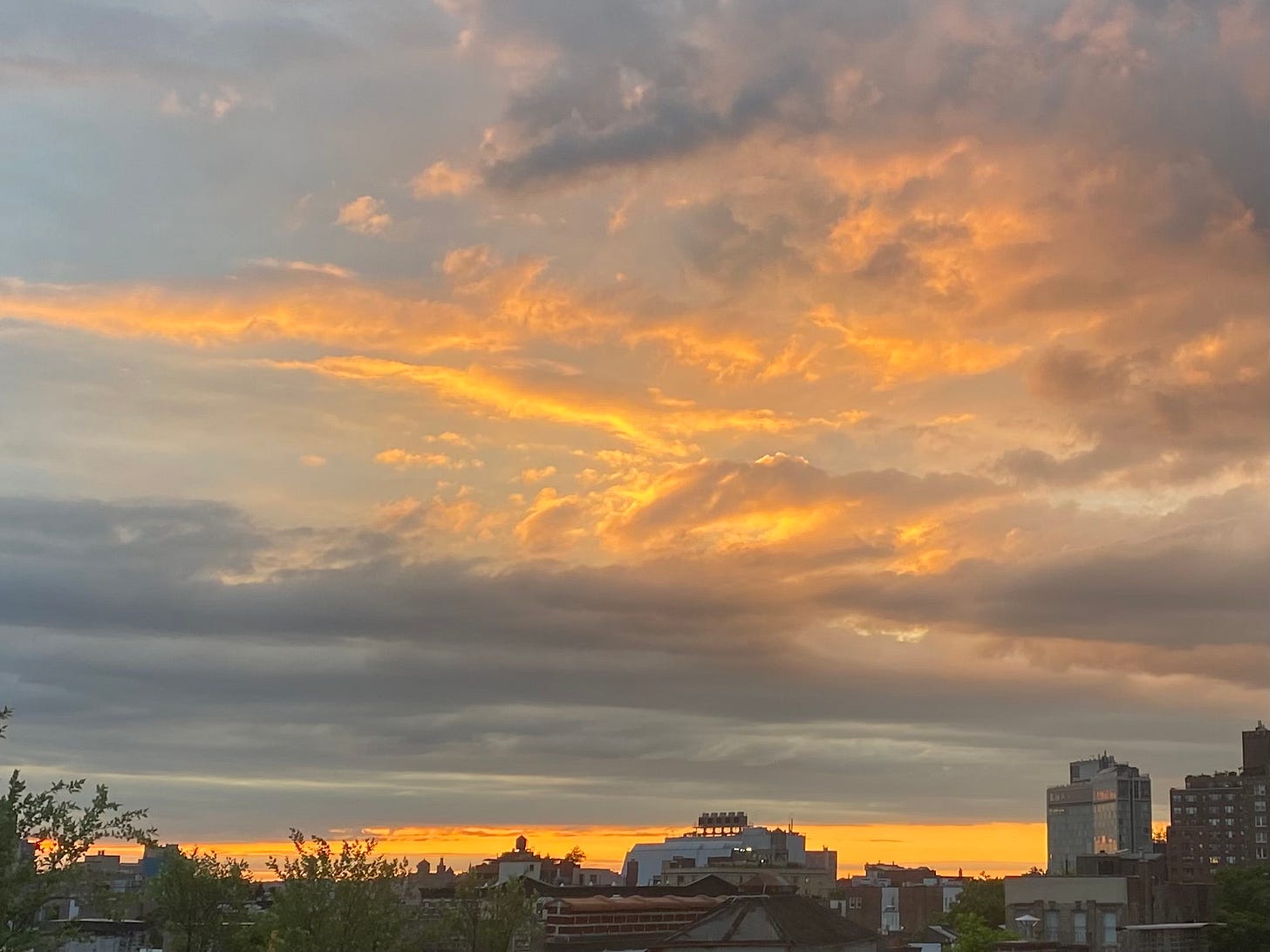Cloud Studies
Billy Collins, John Constable & sneaking up to my roof
The clouds were good clouds tonight. I got drunk on them at a glance, paused in the middle of the crosswalk on 14th street.
On 11th, I had to check to make sure they were still in the sky and almost stepped right into the massive puddle that shows up there anytime it rains. It rained today. Poured. I saw it out the window and was hoping you weren’t getting wet on your walk home from the taco shop.
The clouds were still there.
When I got home to my apartment, top floor, turret, tower, I turned on some lights and opened the curtains and pressed my face against the glass, craned my neck. the clouds were still there.
I became hungry and desperate, a woman possessed. My feet started to itch. A song threatened to rip itself out of my throat. I considered ripping the screen out of the window that leads to fire escape instead. I thought about the bugs that the not-ripped screen keeps out.
Unable to tolerate pane-of-glass separation, I put on the robe that my mom used to wear in the mornings, and a pair of slippers, and I almost forgot my keys on my way out the door—such a rush I was in.
Quietly hopped up the final flight of stairs to the actual top top. Stood where I’ve stood before considering for a moment the no-trespassing-alarm-will-sound-ness of it all.
Pushed the handle and inhaled the silence and stepped out onto the roof. And the clouds were still there.
I picked up a book of Billy Collins’s poetry a few weeks ago in New Orleans—Questions about Angels—and there’s a poem in it called “Student of Clouds.” It’s about the 18th century English painter, John Constable and his cloud studies. He “was a student of clouds / and filled shelves of sketchbooks with their motion, / their lofty gesturing and sudden implication of weather.”
I didn’t know who Constable was, so I had to look him up. According to the Yale Center for British Art, he produced over 100 such pure cloud, no-horizon-line studies. It was an exercise that he referred to as “skying.”
Collins imagines Constable, looking up at the sky, the clouds bounding across it, trying with his pencil to keep up with their motion, “their high voyaging / and the silent commotion of their eddying and flow.” And even though my favorite types of clouds are the ones that sit big and fat and satisfied in the sky, looking like they’re not moving at all, I find the temporality of this image so moving.
The painter is always trying to freeze time, to paint the fruit before it starts to rot. But to paint the clouds? “Tumbling into their centers / and swirling off at the burning edges in vapors / to dissipate into the universal blue of the sky.” To paint that?! And Constable could do it, because he was a good student.
You see, Collins poses a problem for his modern day reader—“In photographs we can stop all this movement now / long enough to tag them with their Latin names.” A sure way to take the life straight out of something is to trap it and name it. Isolate, categorize, explain. And school children sit memorizing their “shapes and meanings.” Can you memorize a meaning? Putting a name to something is a way to love it, but is it a selfish way? One thing is certain—this is not the right way to be a student of clouds.
For Collins, the clouds on Constables canvases, unlike those in a photograph or a school room drawing, “appear / to be moving still in the wind of his brush, / inching gout of England and the nineteenth century / and sailing over these meadows where [he is] walking.” They are still but don’t feel trapped. They’re here for just a moment, they tell you haughtily that they won’t be staying long. And just so, the clouds in Collins’s poem feel like they’re moving still to me. Reflected but uncaptured.
In this regard, his closing image, his “thoughts arranged like paint on a high blue ceiling,” knocked me a bit sideways. Here, after this reverence for the clouds is what seems to be a personal claim to grandiosity. Important, godly things get painted on high blue ceilings. Things like clouds, but maybe also things like thoughts of clouds. I don’t have a paintbrush, but like Collins, I too am a student of clouds. I have my thoughts and my words.
Since the first night I went up to my roof, I’ve become somewhat addicted and I’ve found myself there, well, every night. Usually I just go up for a few minutes to drink up the sky. I’ve been making a practice of looking up at the clouds when I’m on my way home from work, just to find out if I’ll need to pop up there, so as to continue being alive. The answer seems to always be that I will. I will need to.
After the first couple nights, I stopped trying to take pictures. Instead of taking a picture, I want to open my mouth and swallow the scene whole. Get it inside of me, so that the backs of my eyeballs can see it too. This past Tuesday, the sunset was so astonishing, I cried.
Last night I brought two friends and we had a pizza and wine sitting on picnic blankets. Our spot was in the corner, tucked out of sight from the door, and we tried to only walk on the side of the roof that sits above my own apartment. Quiet footsteps, quiet footsteps.
When building management threatens to evict me, I’ll be able to say that I didn’t even want to go up there the first time—I was forced! I would have died maybe if I didn’t—or started singing in Italian or maybe even Latin, which would have been bad because neither is a language I speak! You have to forgive me the first trespass at least.
And once you’ve forgiven me that, surely you can understand what happened next. No alarm sounded, it was quiet, the air was delicious, I wasn’t hurting anyone. I could see the clouds better at they flew overhead. See better and feel closer, be a student in the right way.




I love clouds. Once I painted them for 40 days in a row. I’d like to do that again. I spent my childhood under a ceiling of cloud wallpaper that never matched the view of them outside my bedroom window. I was on the sunset side. Today I bought cloud socks in Soho just before I accidentally ran into your mother. Haha.
Beautiful Eve!